
 |

|
| ActiveWin: Reviews | Active Network | New Reviews | Old Reviews | Interviews |Mailing List | Forums |
|
|
|
|
|
DirectX |
|
ActiveMac |
|
Downloads |
|
Forums |
|
Interviews |
|
News |
|
MS Games & Hardware |
|
Reviews |
|
Support Center |
|
Windows 2000 |
|
Windows Me |
|
Windows Server 2003 |
|
Windows Vista |
|
Windows XP |
|
|
|
|
|
|
|
News Centers |
|
Windows/Microsoft |
|
DVD |
|
Apple/Mac |
|
Xbox |
|
News Search |
|
|
|
|
|
|
|
ActiveXBox |
|
Xbox News |
|
Box Shots |
|
Inside The Xbox |
|
Released Titles |
|
Announced Titles |
|
Screenshots/Videos |
|
History Of The Xbox |
|
Links |
|
Forum |
|
FAQ |
|
|
|
|
|
|
|
Windows XP |
|
Introduction |
|
System Requirements |
|
Home Features |
|
Pro Features |
|
Upgrade Checklists |
|
History |
|
FAQ |
|
Links |
|
TopTechTips |
|
|
|
|
|
|
|
FAQ's |
|
Windows Vista |
|
Windows 98/98 SE |
|
Windows 2000 |
|
Windows Me |
|
Windows Server 2002 |
|
Windows "Whistler" XP |
|
Windows CE |
|
Internet Explorer 6 |
|
Internet Explorer 5 |
|
Xbox |
|
Xbox 360 |
|
DirectX |
|
DVD's |
|
|
|
|
|
|
|
TopTechTips |
|
Registry Tips |
|
Windows 95/98 |
|
Windows 2000 |
|
Internet Explorer 5 |
|
Program Tips |
|
Easter Eggs |
|
Hardware |
|
DVD |
|
|
|
|
|
|
|
ActiveDVD |
|
DVD News |
|
DVD Forum |
|
Glossary |
|
Tips |
|
Articles |
|
Reviews |
|
News Archive |
|
Links |
|
Drivers |
|
|
|
|
|
|
|
Latest Reviews |
|
Xbox/Games |
|
Fallout 3 |
|
|
|
Applications |
|
Windows Server 2008 R2 |
|
Windows 7 |
|
|
|
Hardware |
|
iPod Touch 32GB |
|
|
|
|
|
|
|
Latest Interviews |
|
Steve Ballmer |
|
Jim Allchin |
|
|
|
|
|
|
|
Site News/Info |
|
About This Site |
|
Affiliates |
|
Contact Us |
|
Default Home Page |
|
Link To Us |
|
Links |
|
News Archive |
|
Site Search |
|
Awards |
|
|
|
|
|
|
|
Credits |

|
Product: D810E2CA3 Motherboard & Celeron
900MHz |
2D & 3D Graphics
|
Table Of Contents |
The Intel i810E2 chipset comes with a basic 3D graphics controller built-in the 82810E GMCH (Graphic Memory Controller Hub). This 3D controller is based on the i752 graphics controller (an enhanced version of the i740) and uses a Direct AGP bus connection. The 'Direct AGP' connection offers a bandwidth of 800MB/s. Since reduced TCO is the goal of this chipset, the graphics chip pumps the memory it needs directly into the available SDRAM on the system. If this is great to make sure the chipset remains cheap, the 3D performances are clearly decreased. The i810E2 graphic controller comes with a weak 230MHz RAMDAC that is sufficient enough for business applications providing an acceptable refresh rate with resolutions up to 1280x1024. Screen resolution can climb up to 1600x1200 with a refresh rate of 75Hz. Like Matrox or nVidia GPUs, the i752 supports the motion compensation technology for the best possible DVD playback experience. Depending on the motherboard implementation you can have a digital video out port so you can connect your PC to high end TVs or new digital flat panel screens. The i752 graphic chip is compatible with DirectX.
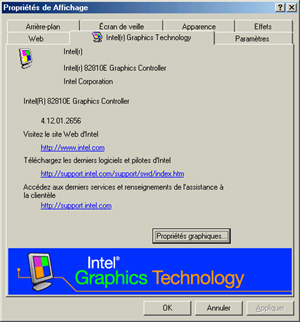

Intel D810E2CA3 Display
Drivers (click to enlarge)
The GMCH is composed of several dedicated 2D/3D engines working in parallel while a pipeline pre-processor treats simultaneously different primitives or portions of the same primitives to render per-pixel scenes. This architecture delivers outstanding 3D graphics with honest performances. The built-in graphics accelerator supports perspective-correct texture mapping, bilinear and anisotropic Mip-Mapping, Gouraud shading, alphablending, fogging and Z-buffering. An optional 4 MB 133MHz Display Cache is included (depending on the motherboard version you have) to enhance the whole 3D performances of the circuit by storing 32 bits Z-Buffer values: it works like a CPU L2 cache speeding up transfer between the GPU and the system memory by storing the most frequently used data. To maximize the performance of the 3D graphic controller (when itís used with system memory) Intel has created the DVMT technology. The Dynamic Video Memory technology ensures the most efficient use of the available memory regardless of frame buffer or main memory sizing to ensure maximum performance. DVMT is aimed to dynamically respond to system requirements by reallocating display & texture memory in real time through Direct AGP and returning memory when itís not required anymore.

Intel D810E2CA3 Display
Cache (click to enlarge)
In terms of 3D performance the i752 doesnít accomplish any miracles. And this for a simple reason! As every GPU the i752 frequently has to store data into a buffer, since thereís no dedicated video RAM, it should use the available system memory that is, most of the time, already bogged down with other running tasks resulting in weak 3D performance. However itís satisfying enough for business applications and casual game play. Many computersí users play occasionally and theyíre definitely not on the look for the ultimate frame rate they can get. Thatís why the i752 is sufficient for non-addicted gamers even if it doesn support 32bits rendering nor texture compression. Serious gamers will remain disappointed to the lack of AGP port letting them upgrade the build in graphic circuit for better performances.
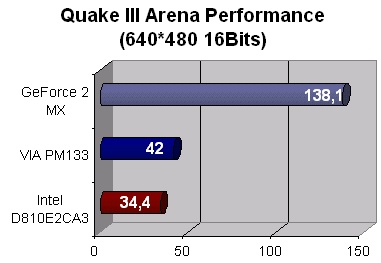 |
Here are the Quake III Arena results you can expect with the i810e2 chipset. Results are expressed in frame per seconds. As you can see VIA chipsets that come with a Savage 4 3D circuit, perform way better than the Intel circuit. For comparison purposes we have put the GeForce 2 MX score you get under Quake III arena (with an i815e, PIII 933MHz system). |
The 2D engine of the GMCH supports almost every 2D graphics standards including: BLT and arithmetic STRBLT engines, hardware cursor and a set of 2D registers and instructions. This 64-bit BitBLT makes sure common Windows programs can benefit with real hardware acceleration for 2D operations.
Onboard Audio
![]() In this
age, users that donít have a sound card on their PC are rare. A sound card
has definitely become essential and unavoidable. At this point every PC -
even those dedicated to office use - comes with such a device. More
demanding users have high-end PCI sound cards to listen and enjoy their
favorite MP3 songs & DVDs. The Intel i810E2 family of chipsets comes with
build in audio support. To my point of view, the sound chip included on
the D810E2CA3 motherboard is simply a marvel even if some power users may
argue it consumes CPU resources to work while a PCI sound accelerator
wouldnít. Well donít get me wrong, the onboard chip isnít designed to
compete with a Sound Blaster Live, but it provides a clear and nice sound
that will please everyone especially music lovers along with some advanced
sound features explained here. Easy to install (you donít need to do
everything since itís integrated), easy to use with powerful and bug free
drivers, and pleasant to hear are the features of SoundMax.
In this
age, users that donít have a sound card on their PC are rare. A sound card
has definitely become essential and unavoidable. At this point every PC -
even those dedicated to office use - comes with such a device. More
demanding users have high-end PCI sound cards to listen and enjoy their
favorite MP3 songs & DVDs. The Intel i810E2 family of chipsets comes with
build in audio support. To my point of view, the sound chip included on
the D810E2CA3 motherboard is simply a marvel even if some power users may
argue it consumes CPU resources to work while a PCI sound accelerator
wouldnít. Well donít get me wrong, the onboard chip isnít designed to
compete with a Sound Blaster Live, but it provides a clear and nice sound
that will please everyone especially music lovers along with some advanced
sound features explained here. Easy to install (you donít need to do
everything since itís integrated), easy to use with powerful and bug free
drivers, and pleasant to hear are the features of SoundMax.
The built-in audio support avoids the need for any supplementary sound card since it performs as well as them and so doesnít waste PCI bandwidth (in case you have a top notch sound card you can always disable this sound circuit). It even prevents headaches from sound card installation issues and other driversí conflicts that can occur with normal sound cards. The integrated ICH2/ACí97 audio solution combined with SoundMax SPX technology is a cost effective solution to provide users with a robust sound quality. SoundMax digitally synthesizes, spatializes and mixes music and voice streams by taking advantage of the processor horse power and companion stereo CODEC (COding and DECoding), achieving a perfect audio parity with consumer electronic devices.
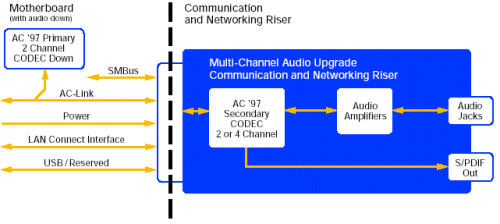
Since the onboard circuit complies to the ACí97 norm it performs analog to digital conversion and perfectly supports simultaneous recording & playback operations. A typical ACí97 solution works like this when you play a wave file: the data is retrieved by the PCI controller, processed by the acceleratorís DSP, converted to ACí97 format and sent over the ACí97 interface to the CODEC. The audio CODEC then converts the PCM audio data to an analog output, which is passed to the back jacks and ultimately to the PC speakers. Today Intel processors offer enough power to perform these DSP effects in software without excessive use of processor bandwidth. In the audio world, the quality of what you hear is measured using decibels: the higher the dB rate (on a scale of 100dB), the higher the sound quality, and the apparatus is able to play near perfect sound. With an approximate rate of 94dB signal-to-noise ratio the SoundMax audio circuit reaches the quality of a good CD player (in comparison a tape deck reaches in best cases 70dB). The circuit supports 44,1kHz sampling rate to deliver outstanding audio and its frequency response covers what the human ear can listen from 20 Hz to 20000Hz. Another surprising feature offered by the SoundMax Digital Audio integrated systems is the Sensaura 3D positional audio and environmental enhancement that lets you experience a full 360į sound.
The same kind of technology is now present in many sound cards and modifies the phase and group delay of outgoing audio signals so users can experience an immersive, three dimensional sound experience. This technique is great especially in games (imagine you can hear your enemies arriving before they appear on your screen, or the bullets flying all around you) and when watching DVD. For high demanding real-time audio applications, SoundMax uses multi-voice DLS Wavetable MIDI synthesises with Staccato SynthCore Audio Rendering Technology to provide physically modelled sound effects capabilities. The professional 4MB DLS2 Sound Set offers 128 high quality recorded instruments while the XGlite Sound Set comes with a 1.2MB memory that contains 360 instruments. If in terms of sound quality the SoundMax circuit doesnít pale at all in comparison to a Sound Blaster Live!, it doesnít offer as many outputs as the SB Live do. Indeed you canít use surround speakers (4 way speakers) or digital ones since they are no SPDIF output. Thankfully you can upgrade the sound circuit with a CNR card to create multi-channel surround sound system by adding two or four analog channels for use with two, four or even six speakers! The quality offered by the SoundMax audio chip is more than sufficient for speech recognition: we tested it with IBM ViaVoice 8.0 Pro and the software has no trouble with it.
SoundMax 3.0 Drivers
We tested the SoundMax Audio circuit with the latest 3.0 drivers release under Windows 2000 Pro and Windows Me. First of all the drivers are using the WDM architecture so they are perfectly compliant with the advanced power management & other DirectX features and perfectly integrated with Windows. DirectSound supported APIS are: A3D 1.0, DirectSound, EAX 1.0, EAX 2.0. The SoundMax drivers offer several software features that let you enhance the depth and strength of bass frequencies for the output signal, models the human HRTF (Head Related Transfer Functions) to position sound effects anywhere in a 3D sound field, and much more. The drivers also let you choose which music synthesizer you want to use, the number of voices that are needed for an optimum playback, etc. The latest 3.0 drivers come with the SPX extension: the Sound Production Extensions technology generate responsive, interactive, and dynamic game sounds in real time in response to game physics, environmental variables, and player input. In the near future more and more games should be released with SPX support.
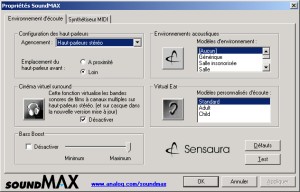
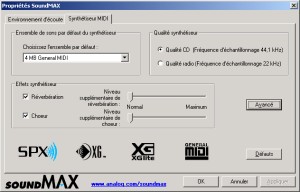
SoundMax Drivers 3.0
Control Panel (click to enlarge)
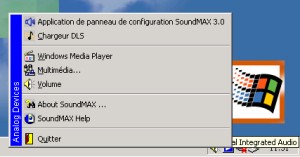
SoundMax Tray Icon Menu
(click to enlarge)
To conclude the audio circuit test, I would say that at a pure acoustic level, the SoundMax ACí97 chip produces a clear, audible and vivid sound with strong basses and present treble. Overall this integrated low cost sound processor provides high quality, top notch sound with tons of features that are usually reserved to expensive sound cardsí owners. Choosing a motherboard built around the SoundMax circuit is definitely a good choice to preserve your budget without sacrificing audio quality.
